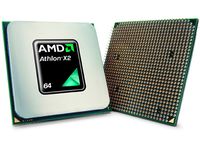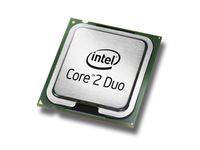Who Says You Need Four Cores?
Confessions Of A Guilty Editor
I have a confession to make. Although I work in a lab filled with the latest hardware, my workstation still consists of a 2.8 GHz Pentium 4 processor. Sure, it features Hyper-Threading, but the chip is six years old. Why am I still using it? Because it runs on a platform that has given me nary a problem. It’s stable, fast enough in Vista to drive four monitors with 15 different windows open at any given time, and remarkably quiet in its little Shuttle box.
But everyone has their limits, and after six years, it’s definitely time to move on. As I considered the pieces for my next PC, I first contemplated an affordable quad-core box based on Intel’s Q9300 or AMD’s Phenom X4 9850 BE. No—I’d rather see how low I could go on the system’s thermal footprint while still achieving reasonable performance.
And then it hit me. Do I really need a quad-core processor? Is the software I run really benefiting from the extra complexity? Could I not get more horsepower from dual-core chip? After all, it’d still be a tremendous upgrade from that 2.8 GHz Pentium 4.
In the interest of full disclosure, my workstation doesn’t touch gaming—nor could it, sporting Nvidia’s Quadro NVS 440. For entertainment I turn to a dual-processor Xeon-based machine that can’t be run after 10:00PM for fear of a noise complaint from the neighbors. Nevertheless, I have to imagine that there are plenty of enthusiasts out there with a solid little desktop sputtering along doing menial productivity-type tasks. So let’s take a look at what it means to upgrade to an affordable configuration with modern components as I build my next six-year system.
The Contenders
There are actually several strong platforms available right now that’d be perfect foundations for a basic workstation upgrade. From AMD, the 780G and 790GX both help save money through capable integrated graphics cores. Nvidia’s GeForce 8200 does the same thing. Intel’s P45 chipset looks to be a strong contender if you don’t mind spending some money on an add-in video card.
However, we’re focusing on two specific chipsets here: AMD’s 740G and Intel’s G45. They aren’t meant to go head-to-head—if they were, we could tell you the performance outcome right now. Rather, the former gives us an ultra-affordable entry point for exploring platform performance, while the latter kicks things up a notch with more current technology. Is the 740G enough? Where are our bottlenecks when we make price the priority? Is Intel’s G45 finally up to snuff with regard to graphics? Most important, do you really need a quad-core CPU or will one of today’s dual-core chips serve up enough muscle to stand the test of time?
Get Tom's Hardware's best news and in-depth reviews, straight to your inbox.
Current page: Confessions Of A Guilty Editor
Next Page AMD’s 740G: From Obscurity To Your Desktop-
Well. It seem like virtualisation was left out as consider multi-core is critical for running virtualise application.Reply
-
apache_lives waste of time to read, its been known for years that you dont compare clock speeds (in this case, 2.53ghz) - you compare price points! Wheres an Intel Quad? or a lower end Intel like a E4600 etc? and after all that BS, why the cheap AMD board thats "$10 - $15 less" against that expensive ass intel board? pfffttttReply -
The_Trutherizer I completely don't get the point of the phenom 9850 in this review. Isn't this supposed to be a comparison of budget, workstation systems with dual core CPUs? Why put it in there? If you put a current Intel quad core in for consideration then it's power consumption would be high as well.Reply
What exactly are you trying to prove here? In any case. Any idiot knows that currently Intel's Dual core is the ideal processor. Currently of course.
And what the hell were you thinking with the motherboard? A 740G? You even state in your conclusion that the 780G is a more fair comparison to the G45? Of course it is! Why did you even review the 740G then?
I mean what a conflicting hodge podge of an article! -
genored If you haven't bought a new computer in 6 years don't do a review about your epic fail of picking computer parts. I mean your just embarrassing....Reply -
rtfm If you give a million monkeys a typwriter, one of them will write a T.H article... Seriously, most of the readers of this site are well informed, this king of waffle is no goodReply -
curryj02 so quad isn't worth it now... what about in six years. just as Hyper Threading has kept his P4 going so long, going quad will have the same effect. Quad doesn't scale now, but in six years? dual core will seem like single core is now - quad core = new dual core. Just my two centsReply -
addiktion I currently run a Q6600 (3GZ OC) and it has done wonders for me. Take it I do a lot of Adobe Photoshop, gaming, coding, and generally have about 20-30+ windows open at one time which I would consider my "business" & "entertainment" use.Reply
If you add virtualization into the mix the quad core definitely has saved me. I don't experience any hiccups and now that I've migrated to 64 bit I've noticed a subtle gain in overall computing too.
I think the highest I've hit on all my cores with extensive testing is 60-70%. This was running a few browser windows + 4 scanning programs at the same time and I did get some slow down due to my hard drive read/write speeds maxing out but nothing from the CPU. Which to me leaves plenty of room for what I actually do.
Eventually when more software actually catches up to using 4 cores it'll be better utilized I suppose but for the most part I'm happy with it and I think you'll be happy with a dual or quad core. -
fepple Running HL2:EP2 as a benchmark is pretty silly when its only single threadedReply
"shocking news! new super car max speed only 30mph in residential areas" -
jitpublisher Nothing surprising, interesting, or useful about this. Am I missing something, was the article incomplete and posted early? Just don't get it.Reply


